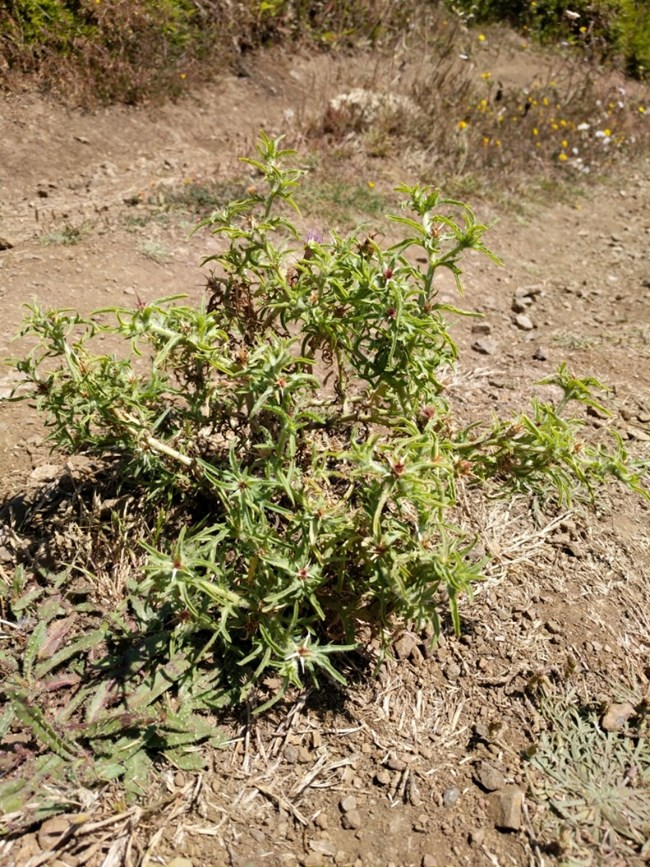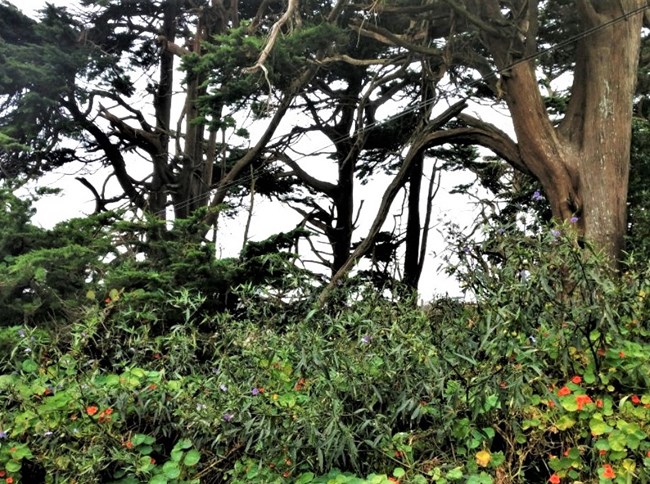Last updated: July 8, 2025
Article
Early Detection News - 2019
2019 Field Season
The Invasive Species Early Detection Team (ISED) conducted surveys in 2019 at Golden Gate National Recreation Area (GOGA), Point Reyes National Seashore (PORE), John Muir National Historic Site (JOMU), and Pinnacles National Park (PINN). Noteworthy detections this year included yellow star thistle and purple star thistle at GOGA, poroporo and Jimson weed at PORE, cheat grass and smilo grass at PINN, and stinkwort at JOMU.
Golden Gate National Recreation Area
Noteworthy Early Detections

NPS / Stephany Dery
Yellow Star Thistle
(Centaurea solstitialis)
In early September, ISED discovered and eradicated a patch of around 30 yellow star thistle growing off of the Baquiano Trail near Pacifica, CA.
Yellow star thistle is one of the most invasive and damaging grassland weeds in western North America. It is native to the Mediterranean Basin, and was first discovered in California in 1869. It now infests over 12 million acres in California, and continues to expand in the Sierras and the central-western region. Yellow star thistle displaces native plants, lowers forage quality on rangelands, and can deplete soil moisture in annual California grasslands. It reproduces rapidly by seed, and is primarily dispersed by human activities. Large amounts of seed can adhere to vehicles and road maintenance equipment and to humans and animals to a lesser degree.
Yellow star thistle is currently uncommon in the coastal zones of Marin and San Mateo Counties. However, its suitable climate range is projected to expand towards the coast over the next 30 years, in response to climate change.
Resources:
Cal-IPC Plant Profile
CalFlora weed profile
Invasive Plants of California's Wildlands

NPS / Stephany Dery
Purple starthistle
(Centaurea calcitrapa)
In early August, ISED revisited Mori Point and discovered two purple starthistles growing in the middle of the Coastal trail. This site had been previously treated in 2016 where three plants were accessed and treated. This section of trail is extremely compact, making the eradication process difficult (hard to dig into the soil without breaking off roots). Since the number of plants was approximately the same size as the previous treatment three years ago, additional follow-up will be necessary to achieve full eradication.
An additional population of purple starthistle was detected and removed off of the Baquiano Trail near Pacifica, CA in mid-September. First detected in the area in 2013, 30 plants were mechanically treated, whereas this year, around 15 plants were hand-pulled. This area should continue to be monitored in the future.
Native to the Mediterranean region, purple starthistle is a major pest of pastures and grassland preserves. Its spines and bitter taste discourages feeling by livestock and wildlife. A perennial plant in the asteraceae family, purple star thistle forms a basal rosette in the first growing season. The leaves are deeply lobed and gray-hairy with light midribs. Mature plants are 1 to 4 feet high with ridged branches and purple flower heads that are surrounded by sharp-pointed spines
Resources:
Noxious Weeds of Marin & Sonoma Counties (MSWMA)
Point Reyes National Seashore
Noteworthy Early Detections

NPS / Stephany Dery
New Zealand Nightshade/Poroporo
(Solanum aviculare)
ISED revisited two sites and recorded a new occurrence poroporo in Point Reyes this September, and, with the help of an Exotic Pest Management Team (EPMT) grant, was able to successfully eradicate the majority. Poroporo is a soft-wooded shrub characterized by deeply lobed leaves, blue-violet flowers, and round, green fruits. Each fruit contains hundreds of seeds, and the plant can reach up to 12 feet high.
The first site was located at Chimney Rock, near the Point Reyes Fish Docks. With the help of loppers and handsaws, the team was able to cut the limbs, collect the seeds, and uproot the entire plant! With high confidence, they moved on to the second site which was off of Sir Francis Drake Blvd near the bird viewing area on Ranch A. Again, the team was able to successfully uproot the plant and collect the seeds.
As the team was finishing up, a local birder asked what they were doing. Excitedly, the team explained that they were working to eradicate the last known populations of Poroporo in the park. The visitor then completely burst their bubble, saying that he saw more plants on the other end of the bird viewing area. Nervously, they walked to the western edge of the viewing area, and sure enough, there was a very dense, very healthy population of poroporo; some plants growing as tall as the power lines! It seems that this site had been overlooked over the years, and will need significant treatment, and plenty of hands to eradicate.
Resources:
Cal-IPC Plant Profile

NPS / Stephany Dery
Jimson weed
(Datura stramonium)
In late September, ISED revisited multiple Jimson weed sites in Point Reyes that had been treated in previous years. Out of the four points that were reassessed in the park, only one contained a large population of the invasive.
Located off of Marshall Beach Rd, near the L Ranch, we were able to visit the site twice and mechanically remove over 400 plants. The majority of the plants were seedlings, and population numbers have increased over the years, making future treatment to this area necessary to achieve eradication.
Datura stramonium is an herbaceous annual in the solanaceae family that grows 1-5 feet tall and can be found in abundance in fields. The green to purplish stems are stout and hollow, and have an unpleasant scent when crushed or bruised. This plant is also highly poisonous to both animals and humans due to its tropane alkaloids which produce the hallucinogenic properties, and may be severely toxic.
Resources:
Invasive Plant Atlas of New England
Pinnacles National Park
Noteworthy Early Detections

NPS / Stephany Dery
Cheat grass
(Bromus tectorum)
At the beginning of the 2019 field season, the ISED field crew spent two weeks at Pinnacles National Park conducting surveys, and completing weed treatments. Over the years, cheat grass has been recorded incorrectly at Pinnacles, so to our knowledge, this population, located on the Balconies trail, is the last known site in the park where it exists. We were able to hand pull over 1,500 plants! It would be quite an achievement, eradicating cheat grass completely from the park, so it should be closely monitored and revisited yearly.Bromus tectorum is an annual grass in the Poaceae family. It is the dominant grass on sagebrush rangelands on the Modoc Plateau in northeastern California and along the eastern Sierra Nevada to Owens Valley. This weed overcrowds native grasslands and croplands. Replacement of native grasses by cheat grass increases the frequency and extent of wildfires.
Resources:
Cal-IPC Plant Profile

NPS \ Stephany Dery
Smilo grass
(Stipa miliacea)
While in Pinnacles National Park, ISED treated the smilo grass populations located in the campground. First seen in 2012, the populations have changed very little, indicating a slow spread. This is positive news, considering no treatments have ever been conducted at this site. This year, ISED received EPMT grant money to carry out treatments, and was able to remove over 150 bunches from the campground. If the park is diligent, it could successfully eradicate it.Smilo grass is a tufted perennial grass in the Poaceae family that thrives in dry or moist sites in disturbed areas, along roadsides and ditches. It can be found scattered along California’s coast and central valley and appears to be increasing in riparian areas and canyons, especially in southern California.
Resources:
Cal-IPC Plant Profile
John Muir National Historic Site
Notewothy Early Detections

NPS \ Stephany Dery
Stinkwort
(Dittrichia graveolens)
Since 2010, ISED has been mapping and controlling stinkwort infestations at John Muir National Historic Site. There are persistent populations at the Mount Wanda Trailhead, and at the Strentzel Creek entrance to the park. This year we mechanically pulled over 320 plants from the Mt. Wanda trailhead, proving that this area has not been successfully eradicated, despite previous records indicating so. ISED also pulled over 600 plants off of the Main Fire trail near the private residences. You can tell that the plants are spreading across the fence line, onto private property. Communicating with landowners and educating them on eradicating this species would help to stop the spread on park lands. Lastly, at the Strentzel Creek entrance to the park, ISED hand-pulled approximately 1,923 plants. Continual surveillance and control will be necessary to keep this rapidly spreading weed out of the park.Stinkwort is a late-season winter annual in the Asteraceae family, native to Mediterranean North Africa. Its foliage is covered in strongly aromatic glandular hairs with a smell reminiscent of Pine-Sol. The plants bear small yellow flowers from September to December. Stinkwort has exponentially expanded its range in California since its initial discovery in 1984 in Santa Clara County. It is found in disturbed habitats, primarily along roadsides in California. It is introduced and spreading rapidly in Central Europe, and has been reported as invasive in Australia and South Africa. In its native range, stinkwort inhabits riparian woodlands, margins of tidal marshes, vernal pools, and alluvial floodplains. It has invaded these types of habitats in some regions where it is introduced, and may ultimately become problematic in similar habitats in California.
A single plant can produce about 15,000 seeds, which are dispersed by wind over 600 feet, accelerating dispersal by animal fur/clothing, fill dirt, mowing and motor vehicles. Seeds can germinate at any time and are only limited by available soil moisture. Stinkwort is known to cause poisoning in livestock and the barbed seed heads can become embedded in sheep's intestines. The plant's sticky resin can cause contact dermatitis in humans.
Resources:
Brownsey RN, Kyser GB, DiTomaso JM (2013) Stinkwort (Dittrichia graveolens) is rapidly expanding its range in California. Calif Agric 67:110–115
Cal-IPC Plant Assessment Form
2019 Season Results
Click on a point in the map below to view additional details about a specific record. This month's ISED records may also be viewed in an interactive map or table at the Calflora Observation Hotline. Navigate to the Help Site for assistance using the Observation Hotline.
